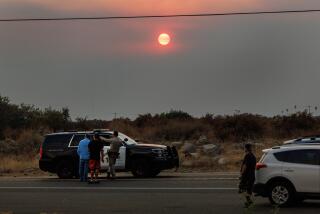AQMD Plan Will Target Pollution in Poor Areas
For the first time in its 50-year history, Southern California’s air quality protection agency adopted a strategy designed specifically to combat toxic air pollution in poor, nonwhite neighborhoods.
The 10-point plan, approved unanimously Friday by the South Coast Air Quality Management District, officially acknowledged the long-standing concerns of “environmental justice” advocates that minority communities bear the brunt of industrial pollution because they are closer to the industries that spew chemicals into the air.
The AQMD initiatives target air quality around so-called toxic hot spots, typically communities where people live close to refineries, chemical plants, large construction projects and other potential sources of toxic pollution.
At the heart of the plan, which will cost nearly $1 million to carry out, is a new monitoring system to analyze toxic pollution in minority communities. The initiatives, proposed last month by AQMD board Chairman William A. Burke, include the immediate creation of a rapid response team to react more quickly to leaks, spills, fires and other industrial accidents.
The action was applauded by environmental groups and industry representatives alike.
“If the board follows through on these initiatives, it will be a historic moment,” said Gail Ruderman Feuer of the Natural Resources Defense Council.
Burke, a Los Angeles businessman and sports promoter, proposed the new policy shortly after his election as the AQMD’s first African American chairman.
Burke has made it clear that he thinks the agency, which is based in Diamond Bar, a leafy suburb of the eastern San Gabriel Valley, has been inaccessible and unresponsive to people who live alongside the smokestacks and slag heaps of industrial Los Angeles.
Through a series of task forces, town meetings and community response teams called for in the board’s 10-point agenda, Burke said, the agency can develop a better relationship with communities that have felt neglected.
For years, residents of the Southland’s most industrialized neighborhoods, such as Wilmington, San Pedro, Santa Fe Springs and Huntington Park, have blamed local air pollution for outbreaks of respiratory and digestive illnesses, saying their air is far worse than that breathed by most people in Southern California.
The new monitoring could provide them with evidence of cause and effect that they have lacked. The agency will follow up the monitoring with a reexamination of its much maligned regulations on toxic air contaminants, which are defined as pollutants that can cause a variety of cancers or damage human reproductive organs.
The regulations state how high the cancer risk must be before industries have to reduce the toxic pollutants released into the air.
The current regulations, approved by the AQMD board in 1994, are less stringent than comparable rules adopted in several other states, including New York. They are one-tenth as strict as the regulations recommended by the the agency’s staff but rejected as too expensive by the board.
Though industry representatives supported Friday’s action, any attempt to make the toxic regulations stricter will probably encounter stiff resistance, especially if the monitoring does not support complaints that minority communities are exposed to unusually severe toxic pollution.
In the only political maneuvering before the vote Friday, representatives of the aerospace and petroleum industries successfully lobbied for an amendment postponing any overhaul of the regulations until after results of the hot spot monitoring are in.
Typifying the position taken by industry Friday, Robert Wyman, a lawyer for several major oil and aerospace firms, said he welcomed the environmental justice initiatives, particularly the monitoring.
“I think it’s a fine idea,” Wyman said. “I expect it will generally confirm that we have the cleanest industries in the country.”
Like most industrial operations--factories and refineries--Wyman’s clients are in the “fixed” source category.
If toxic pollution is traced to mobile sources--mostly cars, trucks, buses and construction equipment--it will give industry representatives more ammunition to argue against tougher regulations of their plants’ emissions.
In all other respects, however, the plan was noncontroversial.
In addition to establishing a rapid response team, the AQMD will form an environmental justice task force to look into complaints that its much-debated emissions credit trading program discriminates against poor, minority communities. The program allows industries to avoid installing emissions control equipment at their plants by reducing an equivalent amount of pollution in other ways--often by buying up and scrapping old cars.
The AQMD also will begin holding a series of town hall meetings throughout Los Angeles, Orange, San Bernardino and Riverside counties in areas where people are concerned about environmental justice issues. In addition, the agency will request that the city of Los Angeles include the subject of air quality in its planned forum on environmental justice, scheduled later this month.
Another initiative calls for the AQMD to improve inspection equipment, which often fails to detect low level air quality violations that cause odor, dust and haze. The board also pledged to support efforts by the California Air Resources Board to phase out diesel engines. And the board said it would consider ways to restrict the use of portable engines at construction sites near schools and homes.
Finally, the agency said it will take a more aggressive role in evaluating new construction projects in the region that are expected to have an effect on air quality.
More to Read
Sign up for Essential California
The most important California stories and recommendations in your inbox every morning.
You may occasionally receive promotional content from the Los Angeles Times.










